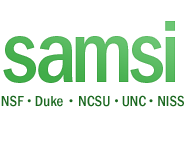What is SAMSI

The Statistical and Applied Mathematical Sciences Institute (SAMSI), was established in 2002. SAMSI is a partnership of Duke University, North Carolina State University (NCSU), the University of North Carolina at Chapel Hill (UNC), and the National Institute of Statistical Sciences (NISS), in collaboration with the William Kenan, Jr. Institute for Engineering, Technology and Science. SAMSI is part of the Mathematical Sciences Institutes program of the Division of Mathematical Sciences at the National Science Foundation. SAMSI is housed at the NISS/SAMSI building in the Research Triangle Park, North Carolina.
MISSION:
SAMSI's mission is to forge a synthesis of the statistical sciences and the applied mathematical sciences with disciplinary science to confront the very hardest and most important data- and model-driven scientific challenges.
VISION:
SAMSI is a formulator and stimulator of research. It conducts programs that target areas most in need of attention and most amenable to high-impact progress. Both established and young researchers from academia, industry, national laboratories and government come to SAMSI to define the central problems and catalyze the research that addresses those problems.
Visiting researchers are resident at SAMSI for periods of a month to a year. Postdoctoral fellows participate at the crucial, formative stage of their careers. Graduate and upper level undergraduate students are provided unique insight into the formation of research areas and collaborations. Every SAMSI program conducts workshops that inform and energize the statistical and applied mathematical sciences. Selective outreach programs to undergraduate and graduate students, high-school teachers and faculty from teaching institutions extend SAMSI’s impact still further.
SAMSI holds regular year long programs, and shorter summer programs, as well as an extensive education and outreach program. Some research programs focus on particular scientific problem areas, while others are defined by statistical and mathematical themes that cut across multiple scientific contexts. Each is led by national and international leaders in the statistical and applied mathematical sciences, coupled with strong involvement of disciplinary scientists. The programming ideas arise from many sources.
